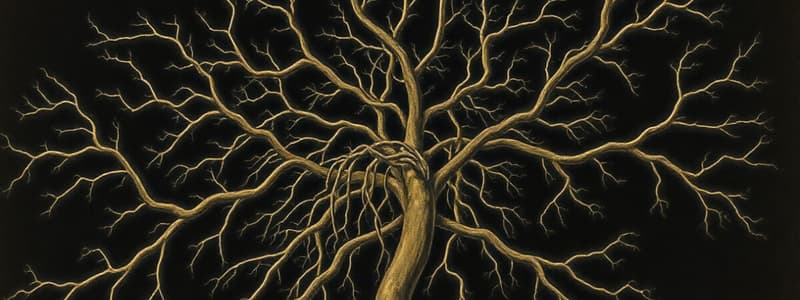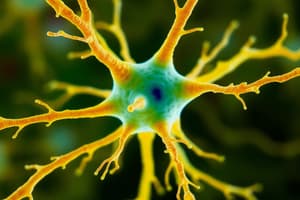Podcast
Questions and Answers
Neurons are specialized for the reception of stimuli and conduction of nerve impulses.
Neurons are specialized for the reception of stimuli and conduction of nerve impulses.
True (A)
Dendrites are processes that conduct impulses away from the cell body.
Dendrites are processes that conduct impulses away from the cell body.
False (B)
Unipolar neurons have a cell body with a single neurite that divides into two.
Unipolar neurons have a cell body with a single neurite that divides into two.
True (A)
Multipolar neurons have a single process arising from their cell body.
Multipolar neurons have a single process arising from their cell body.
Bipolar neurons are characterized by having multiple dendrites and a single axon.
Bipolar neurons are characterized by having multiple dendrites and a single axon.
The central nervous system includes the brain and spinal cord.
The central nervous system includes the brain and spinal cord.
The term 'axon' refers to processes that receive information.
The term 'axon' refers to processes that receive information.
The neuron is the basic working unit of the brain.
The neuron is the basic working unit of the brain.
The dura mater is the innermost layer of the meninges.
The dura mater is the innermost layer of the meninges.
The pia mater is firmly attached to the brain.
The pia mater is firmly attached to the brain.
The arachnoid mater is a delicate, spidery layer located between the dura mater and the pia mater.
The arachnoid mater is a delicate, spidery layer located between the dura mater and the pia mater.
The dural partitions separate different areas of the cranial cavity.
The dural partitions separate different areas of the cranial cavity.
The subdural space is located between the arachnoid mater and pia mater.
The subdural space is located between the arachnoid mater and pia mater.
Arachoid granulations permit one-way flow of CSF to the bloodstream.
Arachoid granulations permit one-way flow of CSF to the bloodstream.
The meninges completely surround only the brain.
The meninges completely surround only the brain.
The outer dural layer is tightly bonded to the vault of the skull.
The outer dural layer is tightly bonded to the vault of the skull.
The sympathetic nervous system is known for its 'rest and digest' response.
The sympathetic nervous system is known for its 'rest and digest' response.
Parasympathetic fibers originate in the thoracolumbar regions of the spinal cord.
Parasympathetic fibers originate in the thoracolumbar regions of the spinal cord.
The sympathetic nervous system increases heart rate and blood pressure.
The sympathetic nervous system increases heart rate and blood pressure.
The preganglionic fibers of the sympathetic nervous system are derived from CNIII, CNVII, CNIX, CNX, and S2-4.
The preganglionic fibers of the sympathetic nervous system are derived from CNIII, CNVII, CNIX, CNX, and S2-4.
The parasympathetic nervous system promotes pupil dilation for distant vision.
The parasympathetic nervous system promotes pupil dilation for distant vision.
The sympathetic ganglia are located close to the target organs.
The sympathetic ganglia are located close to the target organs.
Neuroglia are excitable cells that produce neurotransmitters.
Neuroglia are excitable cells that produce neurotransmitters.
The parasympathetic system is responsible for increasing intestinal and glandular activity.
The parasympathetic system is responsible for increasing intestinal and glandular activity.
Blood vessels to muscles dilate during the fight or flight response.
Blood vessels to muscles dilate during the fight or flight response.
Oligodendrocytes and Schwann cells both produce myelin.
Oligodendrocytes and Schwann cells both produce myelin.
Microglia are specialized macrophages that help remove dead neurons.
Microglia are specialized macrophages that help remove dead neurons.
Ependymal cells form the epithelial lining of the veins in the brain.
Ependymal cells form the epithelial lining of the veins in the brain.
The central nervous system is made up of the brain and cranial nerves.
The central nervous system is made up of the brain and cranial nerves.
The cerebral cortex has surface features known as gyri and sulci.
The cerebral cortex has surface features known as gyri and sulci.
There are 31 pairs of cranial nerves in the human body.
There are 31 pairs of cranial nerves in the human body.
Astrocytes provide nutritional support and help regulate ion concentration.
Astrocytes provide nutritional support and help regulate ion concentration.
The brainstem includes the medulla oblongata.
The brainstem includes the medulla oblongata.
Cerebrospinal fluid is produced by astrocytes.
Cerebrospinal fluid is produced by astrocytes.
The sympathetic chain ganglia are located prevertebrally.
The sympathetic chain ganglia are located prevertebrally.
Visceral sensations originate from blood vessels and internal organs.
Visceral sensations originate from blood vessels and internal organs.
Presynaptic parasympathetic nerve cell bodies are found only in the brain.
Presynaptic parasympathetic nerve cell bodies are found only in the brain.
Sensory ganglia are fusiform swellings located near the ventral root of each spinal nerve.
Sensory ganglia are fusiform swellings located near the ventral root of each spinal nerve.
The spinal nerve is formed by the joining of the anterior motor root and the posterior sensory root.
The spinal nerve is formed by the joining of the anterior motor root and the posterior sensory root.
Somatic sensation is generally less localized than visceral sensation.
Somatic sensation is generally less localized than visceral sensation.
Voluntary motor impulses control skeletal muscle.
Voluntary motor impulses control skeletal muscle.
Cranial nerves V, VII, VIII, IX, and X contain sensory ganglia.
Cranial nerves V, VII, VIII, IX, and X contain sensory ganglia.
Flashcards are hidden until you start studying
Study Notes
Nervous System Cell Types
- Neurons are excitable cells specialized for reception of stimuli and conduction of nerve impulses.
- Neurons vary in size and shape and are found in the brain, spinal cord, and ganglia.
- Neurons have a cell body with one or more processes.
- Dendrites receive information and conduct it towards the cell body.
- Axons conduct impulses away from the cell body.
- Unipolar neurons (pseudounipolar):
- Cell body has a single neurite that divides a short distance from the cell body.
- One neurite proceeds to a peripheral structure (e.g. sensory receptors), the other to the CNS.
- Example: Dorsal root ganglion.
- Bipolar neurons:
- Elongated cell body.
- One end gives rise to an axon, the other end to a dendrite.
- Example: Retinal bipolar cells, sensory cochlear and vestibular ganglia.
- Multipolar neurons:
- Numerous processes arise from the cell body.
- All but one (the axon) are dendrites.
- Example: Most neurons of the brain and spinal cord, motor neurons.
- Neuroglia:
- Non-excitable cells supporting neurons.
- Provide structural support and produce myelin.
- Neuroglia in the CNS:
- Astrocytes: Structural support, insulate synapses, uptake and synthesis of neurotransmitters.
- Oligodendrocytes: Produce myelin.
- Microglia: Specialized macrophages that remove damaged neurons and infections.
- Ependymal cells: Form the epithelial lining of the ventricles in the brain and the central canal of the spinal cord; form the choroid plexus that produces cerebrospinal fluid (CSF).
- Neuroglia in the PNS:
- Schwann cells: Produce myelin.
- Satellite cells: Provide nutritional support and help regulate ion concentration.
Synapse
- Neurons communicate with each other at synapses.
- Pre-synaptic neuron: Neuron conducting the impulse.
- Post-synaptic neuron: Neuron receiving the impulse.
General Organization of the Nervous System
- Functionally:
- Somatic: Controls voluntary movements.
- Visceral (autonomic nervous system): Controls involuntary functions.
- Structurally:
- Central nervous system (CNS): Brain and spinal cord.
- Peripheral nervous system (PNS): Cranial nerves and spinal nerves.
Major Divisions of the CNS
- Brain:
- Forebrain:
- Cerebrum (Telencephalon):
- Surface: Gyri (elevations), sulci (depressions), fissures (deep depressions).
- Five lobes.
- Two separate hemispheres connected by the corpus callosum.
- Diencephalon:
- Cerebrum (Telencephalon):
- Brainstem:
- Midbrain (mesencephalon):
- Pons (metencephalon):
- Medulla oblongata (myelencephalon):
- Cerebellum (metencephalon):
- Forebrain:
- Spinal cord:
- Located within the vertebral canal.
Major Divisions of the PNS
- 31 pairs of spinal nerves and their ganglia.
- 12 pairs of cranial nerves and their ganglia.
Meninges of the CNS
- Dura mater: Tough outer layer.
- Two layers: Outer endosteal layer, inner meningeal layer.
- Arachnoid mater: Delicate, spidery connective tissue layer.
- Separated from dura mater by the subdural space.
- Arachnoid granulations: Projections of arachnoid mater that project into the dural venous sinuses, allowing one-way flow of CSF to the bloodstream.
- Pia mater: Inner layer firmly attached to the brain and spinal cord.
- Dural partitions: Projections of the meningeal dural layer that partially subdivide the cranial cavity.
- Falx cerebri: Divides the two cerebral hemispheres.
- Falx cerebeli: Divides the two cerebellar hemispheres.
- Dural sinuses: Intracranial venous structures.
Autonomic Nervous System (ANS)
- Visceral motor system: Controls involuntary functions.
- Two branches:
- Sympathetic nervous system (SNS): 'Fight or flight' response.
- Increases heart rate and contractility.
- Dilates blood vessels to muscles.
- Derived from cells in the lateral horn T1-L2 (thoracolumbar outflow).
- Parasympathetic nervous system (PSNS): 'Rest and digest' response.
- Decreases heart rate and contractility.
- Constricts bronchioles.
- Relaxes the gut tube muscle.
- Derived from CNIII, CNVII, CNIX, CNX and S2-4.
- Sympathetic nervous system (SNS): 'Fight or flight' response.
Autonomic Nervous System Anatomy
- Sympathetic:
- Fibers originate in the thoracolumbar regions of the spinal cord (intermediolateral cell column of T1-L2).
- Ganglia:
- Paravertebral: Sympathetic chain.
- Prevertebral: Pre-aortic ganglia around the main abdominal arteries.
- Parasympathetic:
- Presynaptic cell bodies are located:
- Brainstem: CNIII, CNVII, CNIX, CNX.
- Sacral segments of spinal cord: S2-S4.
- Presynaptic cell bodies are located:
Important Definitions
- Afferent (sensory) nerve impulses: Carry information towards the CNS.
- Efferent (motor) nerve impulses: Carry information away from the CNS.
- Somatic sensory: Sensation that is acutely aware and well-localized (e.g. touch, pressure).
- Visceral sensory: Sensation that is either imperceptible, vaguely localisable, or only perceptible in disease (e.g. blood pressure).
- Voluntary motor: Controls skeletal muscle.
- Autonomic (visceral) motor: Controls smooth and cardiac muscle, glands, and other internal organs.
Spinal Cord Anatomy
- H-shaped gray matter through which passes the central canal.
- Dorsal horn: Receives sensory information.
- Ventral horn: Contains motorneurons.
- Lateral horn: Contains sympathetic preganglionic neurons (T1-L2) and parasympathetic preganglionic neurons (S2-S4).
Ganglia
- Sensory ganglia:
- Posterior root ganglia: Sensory ganglia found close to the dorsal root of each spinal nerve.
- Cranial nerve ganglia: Sensory ganglia found along cranial nerves V, VII, VIII, IX, X.
- Autonomic ganglia:
- Found in the paravertebral sympathetic chains, around roots of great arteries in the abdomen, and in the walls of viscera.
Spinal Nerves
- Anterior (ventral/motor) root: Carries motor fibers to the periphery.
- Posterior (dorsal/sensory) root: Carries sensory fibers from the periphery.
- The anterior and posterior roots unite to form the spinal nerve, which carries both motor and sensory fibers.
Studying That Suits You
Use AI to generate personalized quizzes and flashcards to suit your learning preferences.




